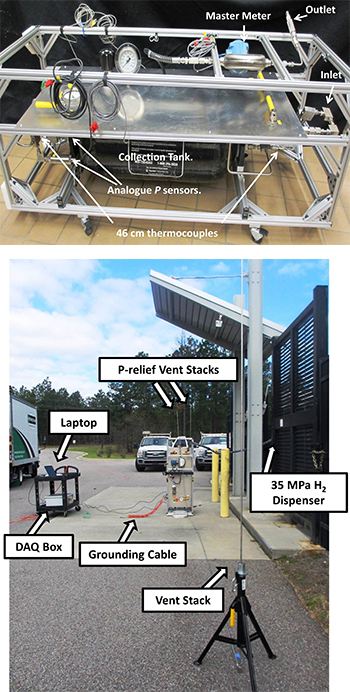Summary
Today, hydrogen-powered demonstration vehicles are refueled from dispensers in 3 to 5 minutes using sequential gas releases from a bank of pressurized cylinders. The sequential releases generate large, rapidly-changing, hydrogen flows (0 to 10 kg/min) spanning a wide pressure range (0 to 70 MPa). Such flows are difficult to measure using off-the-shelf flow meters. To evaluate the performance of retail dispensers at the point of sale, NIST developed a field test standard that includes three independent, mutually-consistent measurement methods. NIST's standard will guide the design of commercially-constructed standards and measurement protocols needed to verify that retail customers get the quantity of hydrogen they pay for. We anticipate that state inspectors will test hydrogen dispensers, much as they now test retail gasoline dispensers. As shown in the figure, NIST's field test measure includes a "master meter" that was calibrated using NIST's Transient Flow Facility (TFF) — a facility designed with this application in mind. (See PubID 914068)
Description

This project provides a metrological tool and standards supporting the fair trade of hydrogen gas as a vehicle fuel of the future.
Objective(s):
The Fluid Metrology Group (FMG) and the Office of Weights and Measures (OWM) collaborated in designing, constructing, and testing a hydrogen gas dispenser field test standard that utilizes three independent measurement methods: 1) gravimetric, 2) PVT, and 3) master meter.
Goals:
Demonstrate safe, affordable, low-uncertainty methods for testing the accuracy of dispensers of hydrogen gas at working pressures up to 35 MPa.
Technical Approach:
To prove the field test standard (FTS) is capable of performing in a field setting, NIST first used the TFF as a high pressure helium gas source to simulate type D dispenser filling of a 1 kg hydrogen capacity vehicle storage tank. The FTS was then taken to a field location to compare the three test methods at a hydrogen dispenser. The storage tank is built into the portable FTS and is equipped with temperature and pressure sensors, a coriolis meter as the master meter, and automated data acquisition. The FTS was evaluated such that the requirements of NIST handbook 44: Hydrogen Gas-Measuring Devices – Tentative Code were met.
During the laboratory phase (Phase 1), we designed, constructed and tested the FTS in a controlled environment. The TFF allows us to: 1) evaluate each field test method using surrogate gases (helium) without the time and safety constraints that will be encountered in the field, 2) use more accurate instruments that are incompatible with high-pressure hydrogen, and 3) achieve the best possible reproducibility. The field tests (Phase 2) was successfully carried out at a hydrogen dispenser.
Major Accomplishments
- FTS design and construction completed.
- Temperature and pressure sensors calibrated and installed
- Data acquisition hardware installed and software complete.
- Phase 1 tests complete
- Phase 2 tests complete
- Peer reviewed journal manuscript in print, https://doi.org/10.1016/j.flowmeasinst.2015.10.010

